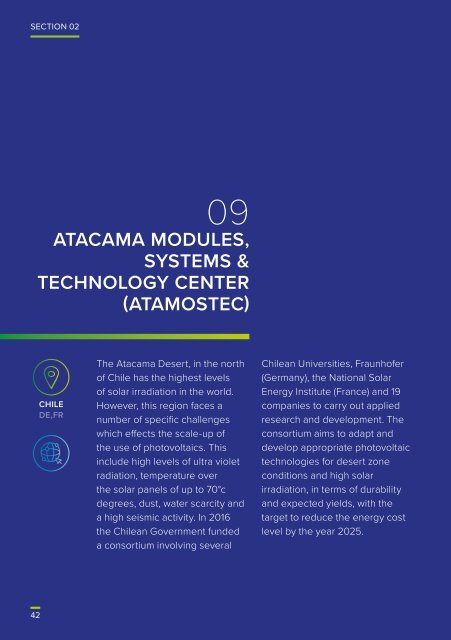MI 2020 Solutions FINAL
You also want an ePaper? Increase the reach of your titles
YUMPU automatically turns print PDFs into web optimized ePapers that Google loves.
SECTION 02<br />
SECTION RENEWABLE 01 | ENERGY<br />
09<br />
ATACAMA MODULES,<br />
SYSTEMS &<br />
TECHNOLOGY CENTER<br />
(ATAMOSTEC)<br />
CHILE<br />
DE,FR<br />
The Atacama Desert, in the north<br />
of Chile has the highest levels<br />
of solar irradiation in the world.<br />
However, this region faces a<br />
number of specific challenges<br />
which effects the scale-up of<br />
the use of photovoltaics. This<br />
include high levels of ultra violet<br />
radiation, temperature over<br />
the solar panels of up to 70°c<br />
degrees, dust, water scarcity and<br />
a high seismic activity. In 2016<br />
the Chilean Government funded<br />
a consortium involving several<br />
Chilean Universities, Fraunhofer<br />
(Germany), the National Solar<br />
Energy Institute (France) and 19<br />
companies to carry out applied<br />
research and development. The<br />
consortium aims to adapt and<br />
develop appropriate photovoltaic<br />
technologies for desert zone<br />
conditions and high solar<br />
irradiation, in terms of durability<br />
and expected yields, with the<br />
target to reduce the energy cost<br />
level by the year 2025.<br />
10<br />
BREAKTHROUGH’S<br />
IN SOLAR CONVERSION<br />
EFFICIENCIES<br />
Japan aims to reduce the cost<br />
of solar power generation to<br />
$0.06 per kWh by 2030 through<br />
its innovation programme. As<br />
part of the programme, several<br />
breakthroughs have been<br />
achieved in this technology area.<br />
Sharp Corporation has achieved<br />
one of the world’s highest<br />
conversion efficiency for a solar<br />
module (31.17% for 968 cm2). A<br />
triple-junction compound was<br />
used to capture a wider range of<br />
the spectrum of sunlight.<br />
Kaneka Corporation has also<br />
achieved the world’s highest<br />
conversion efficiency in a<br />
crystalline silicon solar cell of<br />
practical size (26.33% for 180<br />
cm²). By combining heterojunction<br />
technology, low resistance<br />
electrode technology, and a<br />
back-contact structure achieved<br />
capture of more solar energy.<br />
JAPAN<br />
42<br />
43


